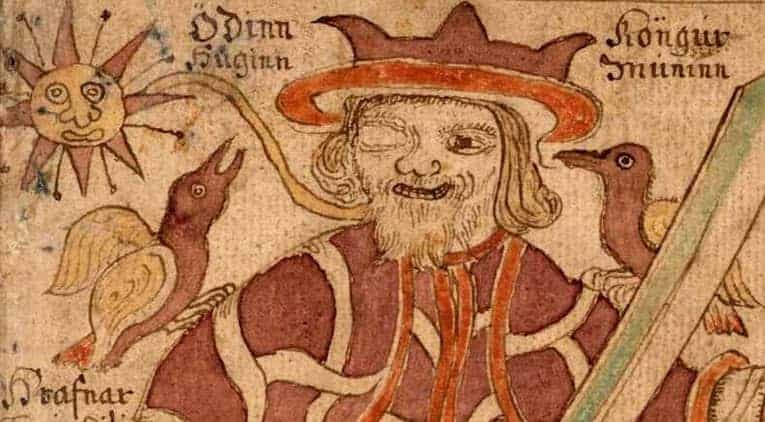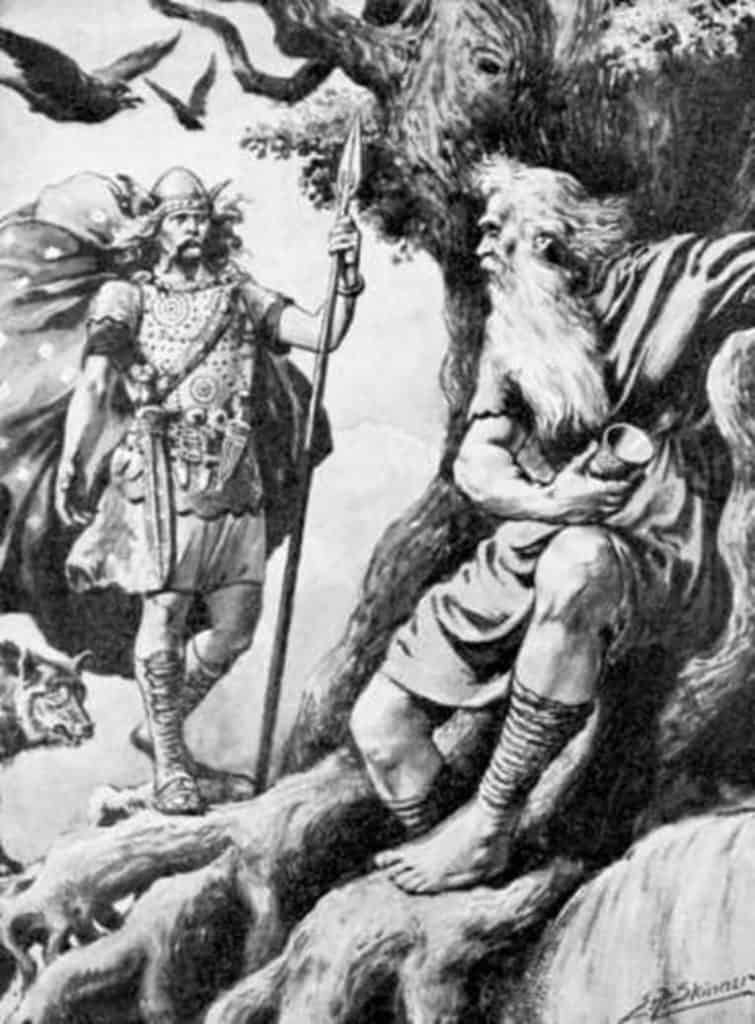In the modern world, Vikings are imagined in various ways based on how movies, and other forms of popular culture, depict them.
However, the real Vikings that existed centuries ago were a culture of strong Norsemen from Scandinavia who invaded the vast expanses of Europe and explored westwards to Iceland, and even to North America, including Greenland. [1]
The Vikings worshiped Odin — the god of the dead and of war — because he was the supreme deity according to the lore found in the worldview of Norse paganism.
Odin was known for his many awe-inspiring deeds, from inventing the runic alphabet to sacrificing his eye in the pursuit of wisdom.
Norse paganism is rooted in rituals rooted in oral tradition. The culture of the Vikings was intricately intertwined with the sagas of the ancient Norse gods.
The Vikings’ deep-rooted beliefs in Norse paganism sheds light on how Odin became one of the most powerful and beloved gods in Viking history.
Wondering why Odin is often depicted with an eye patch? See This Is Why Odin Sacrificed His Eye to learn more.

Who Was Odin?
Odin, also known as the All-Father, was a one-eyed god who sacrificed his eye in exchange for knowledge of the runes. [2]
He was also the ruler of the Aesir, a group of deities in Norse mythology.
Odin was primarily known as the god of war, wisdom, magic, and poetry.
Additionally, his name stood for “fury” or “frenzy,” which is strikingly similar to how the Vikings have established themselves in history. [3]
In Norse belief, Odin is connected to, and responsible for, the creation and eventual destruction of the world.
The Vikings believed that Odin and his brothers Vili and Ve created the universe using the flesh and bones of a giant they had slain.
Odin then created the heavens for the gods, Earth for mankind, and the underworld for the dead. [4]
Many historians believe that the figure of Odin may have originated in the early myths of the Germanic people.
Whatever gave him rise, it is clear that belief in his existence, and particular attributes, motivated the Vikings, guiding them in their endeavors.
Odin was known by more names than just Odin. See Why Did Odin Have So Many Names? to learn more.

The Feats of Odin
Odin was acclaimed for many heroic feats and for his character qualities.
In addition to being the creator of the universe, he is also ascribed great wisdom as well as the ability to see into the future.
The Vikings saw Odin as an omniscient god who sacrificed his eye for the gift of wisdom.
This sacrifice also gave him knowledge of the runes, which were Norse symbols used for writing.
Odin was a warrior who was so successful, he never lost a battle. (Also see Does Odin Live in Valhalla?)
Some legends refer to Odin as a shape-shifter who had a love for poetry and has always been the source of poetic talent from whom poets among human beings emerged. [5]
Odin was pictured as a wise old man with a white beard who roamed on Earth wearing a blue cloak, surrounded by various animals, especially flesh-eaters like wolves and ravens who scavenged battlefields.
Odin and Zeus are the chief gods in their respective mythologies. See Would Odin Beat Zeus In a Fight? learn more.
Odin and the Vikings
Belief in Odin developed into a central part of the Vikings’ worldviews in the 8th and 9th centuries.
As conflict with neighbors tribes, increased, Viking fighters sought courage and motivation.
The year 793 marks the first record of Viking invasions on the coastal regions of northwest Europe, which would last more than two centuries.
This established their legacy as fierce and ruthless warriors.
Beserkers: An elite band of Vikings fighters, known as the “beserkers,” gave special attention to Odin for the purpose of extracting strength, courage, and protection, from him. [6]
They wanted to duplicate his seemingly super-human, other-worldly accomplishments in battle.
As fighting and raising increased, Vikings gave more and more attention to the god they attributed success to, Odin.
Victories were associated with properly honoring and revering Odin. Defeats may signal that their worship and reverence of him was inadequate.
The centrality of Odin in the Vikings’ worldview can be measured in part by their representation of him in art.
As the Vikings rose in power in Northern Europe, Odin became a more prominent figure among Norse poets and artists.
Valhalla and Valkyries
Viking fighters believed that Odin gave particular attention to them.
People believed he was present in victory, and especially with those who died in battle.
Their hope was to live eternally in Valhalla. which was an everlasting hall of slain Viking warriors, where Odin resided.
Upon death, it was believed that worthy Vikings would be transported to Valhalla by means of creatures female creatures called Valkyries.
Odin awaited their arrival and would honor their sacrifice. Such fighters would be immortalized along with the other life-giving Vikings of the past.
Those who were carried to Valhalla were referred to as “Einherjar,” meaning “army of one.”
To be an Einherjar a Viking had to die in battle.
Many Viking men desired this honor, which motivated them to fight to the death in raids and larger conflicts.
Forms of Worship
Because of their allegiance to Odin, and the worldview of Norse paganism, other Europeans referred to Vikings as barbarians.
This negative connotation was due in part to some of the extreme practices not common in other religions such as Judaism, Christianity, and Islam — human sacrifice.
Human sacrifices often included the victim being speared and then hung in a ritualistic practice.
Such sacrifices were done in remembrance of Odin, who was was believed to have hung from a mythical tree called Yggdrasil after stabbing himself with a spear called a Gungnir.
Odin did this in pursuit of the hidden knowledge of the runes.
These sacrifices were carried out to pay homage to Odin, who underwent the same suffering.
Odin and other Viking gods
Though Odin was the All-Father, other Norse gods were ranked below him that the Vikings were also worshiped and revered.
The Norse gods can be divided into two major clans: Aesir and Vanir.
Odin, Frigg, Thor, Loki, Balder, Hod, Heimdall, and Tyr are the most prominent gods of Aesir and were loved and worshiped by the Vikings.
Like Odin, all these other deities represented different areas of the Vikings’ lives and controlled the natural elements around them.
Hence, the Vikings always had a god to pray to when they faced environmental disturbances.
The second clan, Vanir, represented other important figures, like the gods of fertility.
Hence, both the clans were highly esteemed and worshiped by the Vikings in order to live a prosperous and happy life in this world and the next. [7]
Odin in other literature
Roman historians were the first to write down the history of the Germanic people. In their records, they refer to Odin as Mercury, who was their chief deity at the time.
They assumed they must be the same god based on the similarities between Odin and Mercury. [8]
Generally, one can find similar stories of gods and goddesses narrated in slightly varied forms in the literature of different cultures.
This could be due to similar oral traditions, which get edited in different people groups, as they’re passed down from one generation to the next.
In ancient times, gods and goddesses were sometimes customized to fit the needs of the people.
If a clan consisted of warriors and needed courage and strength to conquer new lands, they benefited from belief in heroic gods who would be able to influence and protect them as they set out for conquest.
References:
[1] Source
[2] Source
[3] Source
[4] Source
[5] Source
[6] Source
[7] Source
[8] Source
